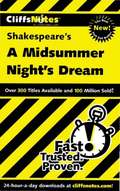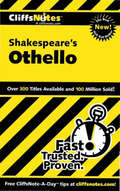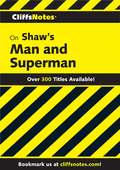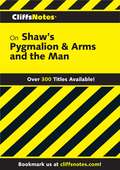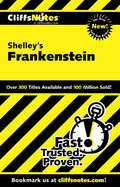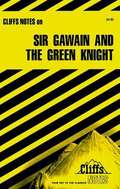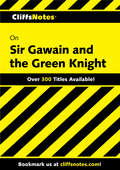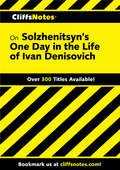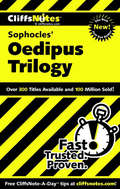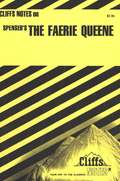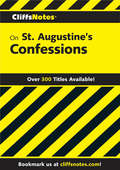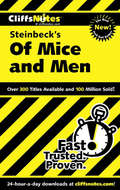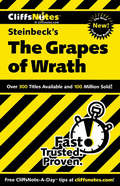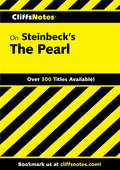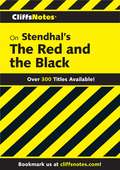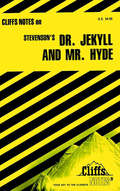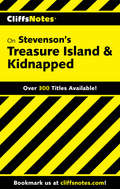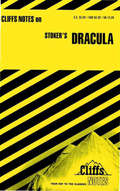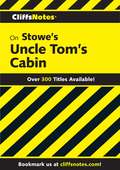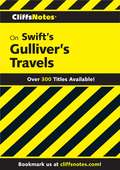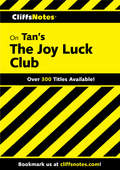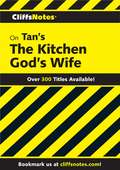- Table View
- List View
CliffsNotes on Shakespeares A Midsummer Nights Dream
by Karin JacobsonThe original CliffsNotes study guides offer a look into critical elements and ideas within classic works of literature.In CliffsNotes on A Midsummer Night's Dream, you dig into Shakespeare's entertaining story of young lovers as they're toyed with by mischievous forest sprites.Shakespeare claimed to have written this romantic comedy to show that "love hath no law but its own." This study guide follows the action from scene to scene with commentaries that bring sense to the entertaining play, which is neither realistic nor tragic. Other features that help you figure out this important work includeLife and background of the authorIntroduction to and synopsis of the playAnalyses of all the characters and a character mapSummaries of each of the five actsA review section that tests your knowledge and suggests essay topicsClassic literature or modern-day treasure -- you'll understand it all with expert information and insight from CliffsNotes study guides.
CliffsNotes on Shakespeares Othello
by Gary K Carey Helen MccullochThe original CliffsNotes study guides offer expert commentary on major themes, plots, characters, literary devices, and historical background. The latest generation of titles in the series also feature glossaries and visual elements that complement the classic, familiar format. Betrayal and manipulation lie at the heart of Othello. Keep up with all the crosses and double-crosses of this tragic play with the CliffsNotes version of the play, which will help you form your own opinions about Iago's schemes, Othello's motives, and Desdemona's loyalty. Other features that help you study include Background information about the life and times of William Shakespeare to help you understand his influences A character map that graphically illustrates the relationships among the characters Glossaries to help you comprehend Shakespeare's language Critical essays on the character pairs and major themes of the play A review section that tests your knowledge Classic literature or modern modern-day treasure--you'll understand it all with expert information and insight from CliffsNotes study guides.
CliffsNotes on Shaw's Major Barbara & St. Joan
by Jeffrey FisherThis CliffsNotes guide includes everything you’ve come to expect from the trusted experts at CliffsNotes, including analysis of the most widely read literary works.
CliffsNotes on Shaw's Man & Superman
by James K LowersThis CliffsNotes guide includes everything you’ve come to expect from the trusted experts at CliffsNotes, including analysis of the most widely read literary works.
CliffsNotes on Shaw's Pygmalion & Arms and the Man
by James K Lowers Marilynn O HarperIn Pygmalion, Shaw presents the classical story of a professor who transforms a girl of the lower class into an elegant creature, who then falls in love with him—unfortunately in love, that is. Set in Bulgaria, Arms and the Man satirizes romantic attitudes about love and war. Raina, the heroine, falls in love with a cowardly, chocolate-loving enemy soldier during an unnamed war. After the war, her fiance challenges her new admirer to a duel, loses heart, and proposes to the maid instead.
CliffsNotes on Shelley's Frankenstein
by Jeff CoghillThe original CliffsNotes study guides offer a look into key elements and ideas within classic works of literature. The latest generation of titles in this series also features glossaries and visual elements that complement the familiar format.CliffsNotes on Frankenstein digs into Dr. Victor Frankenstein's scientific creation, a "hideous and gigantic" monster that the good doctor tries to defeat throughout most of the novel.Following the story of an obsessive man whose determination to create a new race of humans produces monstrous results, this study guide provides summaries and critical commentaries for each part within the novel. Other features that help you figure out this important work includePersonal background on the author, including career highlightsIntroduction to and synopsis of the bookIn-depth analyses of the principal charactersCritical essays on the book's themes, plots, and moreReview section that features interactive questions and suggested essay topicsResource Center with books, films and other recordings, and Web sites that can help round out your knowledgeClassic literature or modern-day treasure -- you'll understand it all with expert information and insight from CliffsNotes study guides.
CliffsNotes on Sheridan's The Rivals & The School for Scandal
by A. M. FiskinThis CliffsNotes guide includes everything you’ve come to expect from the trusted experts at CliffsNotes, including analysis of the most widely read literary works.
CliffsNotes on Sir Gawain and the Green Knight
by John GardnerLanguage and style, summaries and commentaries on Pearl, Patience, and Sir Gawain and the Green Knight.
CliffsNotes on Sir Gawain and the Green Knight
by John GardnerThis Middle-English poem about the moral testing of a young hero is commonly described as the greatest Arthurian romance in our literary tradition. It is a question still as to who the author is, but this poet is considered second only to Chaucer.
CliffsNotes on Solzhenitsyn's One Day in the Life of Ivan Denisovich
by Franz G. BlahaThis CliffsNotes guide includes everything you’ve come to expect from the trusted experts at CliffsNotes, including analysis of the most widely read literary works.
CliffsNotes on Sophocles' Oedipus Trilogy
by Regina Higgins Charles HigginsThe original CliffsNotes study guides offer expert commentary on major themes, plots, characters, literary devices, and historical background. The latest generation of titles in this series also feature glossaries and visual elements that complement the classic, familiar format.CliffsNotes on The Oedipus Trilogy is your ticket to a greater understanding of three tragic dramas from Sophocles. Meet the subject of these plays: Oedipus, the banished king of Greek mythology who killed his father and married his mother. Oedipus The King, Oedipus at Colonus, and Antigone are timeless works that continue to captivate audiences even today.This study guide covers all three plays with critical commentaries, summaries, and character analyses -- tools designed to open your eyes to the richness of Sophocles' work. Other features that help you study includeLife and background of the playwright, SophoclesAn introduction to Greek theatreA character map that graphically illustrates the relationships among the charactersCritical essays on fate and ritual and transcendence in the Oedipus TrilogyA review section that tests your knowledgeA Resource Center full of books, films, and Internet sitesClassic literature or modern modern-day treasure -- you'll understand it all with expert information and insight from CliffsNotes study guides.
CliffsNotes on Spenser's The Faerie Queene
by Harold M PriestThis CliffsNotes guide includes everything you've come to expect from the trusted experts at CliffsNotes, including analysis of the most widely read literary works.
CliffsNotes on St. Augustine's Confessions
by Stacy MagedanzThe original CliffsNotes study guides offer expert commentary on major themes, plots, characters, literary devices, and historical background. The latest generation of titles in this series also features glossaries and visual elements that complement the classic, familiar format.CliffsNotes on St. Augustine’s Confessions takes you on a story of conversion – actually several conversions: to Manichaeism; to the pursuit of truth; to an intellectual acceptance of Christianity; and finally to an emotional acceptance of Christian faith. The Confessions is in one sense Augustine’s personal story, but it is also a mythological work about humanity’s quest to discover true peace and satisfaction.Examine the many layers of this masterpiece with help from a study guide you can trust. You'll also gain insight into the background and influences of the author. Other features that help you study include Chapter by chapter summaries and commentariesCritical essaysA review section that tests your knowledgeA Resource Center full of books, articles, films, and Internet sitesClassic literature or modern-day treasure—you'll understand it all with expert information and insight from CliffsNotes study guides.
CliffsNotes on Steinbeck's Of Mice and Men
by Susan Van KirkThe original CliffsNotes study guides offer expert commentary on major themes, plots, characters, literary devices, and historical background. The latest generation of titles in the series also feature glossaries and visual elements that complement the classic, familiar format. In CliffsNotes on Of Mice and Men, you'll meet drifters Lennie and George and recount their peculiar difficulties and unusual bond. The CliffsNotes commentaries, summaries, and character analysis will show you why this sweet, sad, and moving American story is considered to be one of Steinbeck's greatest works. You'll also find Life and background of the author, John Steinbeck A short introduction to the novel A character map that graphically illustrates the relationships among the characters Critical essays A review section that tests your knowledge A Resource Center with books, Web sites, films, and magazine articles for further study Classic literature or modern modern-day treasure - you'll understand it all with expert information and insight from CliffsNotes study guides.
CliffsNotes on Steinbeck's The Grapes of Wrath
by Kelly M. VlcekThe original CliffsNotes study guides offer a look into key elements and ideas within classic works of literature. The latest generation of titles in this series also features glossaries and visual elements that complement the familiar format.CliffsNotes on The Grapes of Wrath explores John Steinbeck's Pulitzer Prize-winning --and controversial - novel, a work based on the what the author saw for himself as a reporter covering migrant worker camps.Following the story of the Joad family as they travel from the Oklahoma Dust Bowl to California in search of farming opportunities and wealth, this study guide provides summaries and critical commentaries for each part within the novel. Other features that help you figure out this important work includePersonal background on the author, including career highlightsIntroduction to and synopsis of the bookIn-depth character analysesCritical essays to take you into the author's personal philosophyReview section that features interactive questions and suggested essay topics and practice projectsResource Center with books, films, and Web sites that can help round out your knowledgeClassic literature or modern-day treasure -- you'll understand it all with expert information and insight from CliffsNotes study guides.
CliffsNotes on Steinbeck's The Pearl (Cliffsnotes Ser.cliffs Notes Series)
by Eva FitzwaterThe original CliffsNotes study guides offer expert commentary on major themes, plots, characters, literary devices, and historical background. The latest generation of titles in this series also feature glossaries and visual elements that complement the classic, familiar format.In CliffsNotes on Steinbeck's The Pearl, you’ll meet a simple family brought to a tragic end. Their pearl is supposed to bring their child out of darkness; he will be able to learn to read and write, and he will then be able to help all of the natives. Instead, the pearl becomes the direct instrument of the child’s death.This concise supplement to Steinbeck's The Pearl helps you appreciate the novel on an aesthetic, ecological, or sociological vein. Features that help you study include Chapter-by-chapter summaries and commentariesA list of characters and analyses of the major playersLife and background of the author, John SteinbeckA Critical approach to the novelA review section that tests your knowledgeA selected bibliographyClassic literature or modern-day treasure—you'll understand it all with expert information and insight from CliffsNotes study guides.
CliffsNotes on Steinbeck's The Red Pony, Chrysanthemums, and Flight
by Gary K Carey John G. IronsThis CliffsNotes guide includes everything you’ve come to expect from the trusted experts at CliffsNotes, including analysis of the most widely read literary works.
CliffsNotes on Stendhal's The Red and the Black
by D. L. GobertThis CliffsNotes guide includes everything you’ve come to expect from the trusted experts at CliffsNotes, including analysis of the most widely read literary works.
CliffsNotes on Stevenson's Dr. Jekyll and Mr. Hyde
by James L RobertsThe original CliffsNotes study guides offer a look into critical elements and ideas within classic works of literature. CliffsNotes on Dr. Jekyll and Mr. Hyde explores the double life of a man whose persona swings from honorable and distinguished to repugnant and repulsive. Following a fascinating character study, this study guide provides summaries and commentaries for each chapter within the nineteenth-century novel. Other features that help you figure out this important work include A look into the life of the author, Robert Louis Balfour Stevenson Character list and expanded analysis Plot summary that shares an overview of the novel Review questions and suggested essay topics Selected bibliography Classic literature or modern-day treasure -- you'll understand it all with expert information and insight from CliffsNotes study guides.
CliffsNotes on Stevenson's Treasure Island & Kidnapped (Cliffsnotes Ser.cliffs Notes Series)
by Gary K CareyThese novels of pirates on the high seas and intrigue in the Scottish highlands were written on a challenge by Stevenson's teenage stepson to "write something really interesting." The results are these fast-moving and adventurous books, simple and entertaining.
CliffsNotes on Stoker's Dracula
by Samuel J UmlandThe original CliffsNotes study guides offer a look into critical elements and ideas within classic works of literature. The latest generation of titles in this series also features glossaries and visual elements that complement the classic, familiar format. CliffsNotes on Dracula digs into the story of a count who survives by sipping the blood from living (and unsuspecting) donors. Following the hauntingly frightful tale of vampires and victims, this study guide provides summaries and commentaries for each chapter within the nineteenth-century novel. Other features that help you figure out this important work include A look into the life of the author, Bram Stoker Character list and plot synopsis An essay exploring the influence of German Expressionism on the American horror film A list of Dracula film productions, with ratings for each Suggested discussion questions Classic literature or modern-day treasure -- you'll understand it all with expert information and insight from CliffsNotes study guides.
CliffsNotes on Stowe's Uncle Tom's Cabin (Cliffsnotes Ser.)
by Thomas Thornburg Mary ThornburgThe original CliffsNotes study guides offer expert commentary on major themes, plots, characters, literary devices, and historical background. The latest generation of titles in this series also feature glossaries and visual elements that complement the classic, familiar format.In CliffsNotes on Uncle Tom's Cabin, you discover Harriet Beecher Stowe's most memorable and socially relevant novel—a book that, when published in 1852, galvanized public opinion against slavery in a way never seen before. The story follows the lives of two slaves: Eliza, who escapes slavery with her son, and Tom, who must endure humiliation, abuse, and torture inflicted by his owners.This study guide takes you though Eliza and Tom's journeys by providing summaries and commentaries on each chapter of the novel. Critical essays give you insight into the major themes of the novel, as well as the novel's structure and Gothic elements. Other features that help you study includeCharacter analyses of the main charactersA character map that graphically illustrates the relationships among the charactersA section on the life and background of Harriet Beecher StoweA review section that tests your knowledgeA Resource Center full of books, articles, films, and Internet sitesClassic literature or modern-day treasure—you'll understand it all with expert information and insight from CliffsNotes study guides.
CliffsNotes on Swift's Gulliver's Travels
by A. Lewis Soens Jr. Patrick J. SalernoThis CliffsNotes guide includes everything you’ve come to expect from the trusted experts at CliffsNotes, including analysis of the most widely read literary works.
CliffsNotes on Tan's The Joy Luck Club
by Laurie Neu RozakisThe original CliffsNotes study guides offer expert commentary on major themes, plots, characters, literary devices, and historical background. The latest generation of titles in this series also feature glossaries and visual elements that complement the classic, familiar format.Explore how generational and cultural differences can divide — and then unite — immigrant mothers and their American-born daughters as you study CliffsNotes on The Joy Luck Club.This novel describes the lives of four women, who fled China in the 1940s, and their contentious relationships with their four very Americanized daughters. Through the love of their mothers, each of these young women learns about her heritage and so is able to deal more effectively with her life.CliffsNotes provides detailed plot summaries, critical commentaries, and a helpful character list to help you uncover all the insight this novel has to offer. Make studying easier with CliffsNotes on The Joy Luck Club. Other features includeCritical essaysA review section that tests your knowledgeBackground on the author, including career highlightsClassic literature or modern modern-day treasure — you'll understand it all with expert information and insight from CliffsNotes study guides.
CliffsNotes on Tan's The Kitchen God's Wife
by Mei Li RobinsonThis CliffsNotes guide includes everything you’ve come to expect from the trusted experts at CliffsNotes, including analysis of the most widely read literary works.
